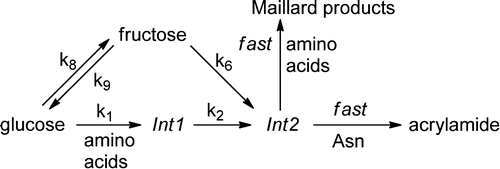Reducing acrylamide levels in french fries

The process for preparing frozen, par-fried potato strips—distributed to some food outlets for making french fries—can influence the formation of acrylamide in the fries that people eat, a new study has found. Published in ACS' Journal of Agricultural and Food Chemistry, the study identifies potential ways of reducing levels of acrylamide, which the National Toxicology Program and the International Agency for Research on Cancer regard as a "probable human carcinogen."
Acrylamide forms naturally during the cooking of many food products. Donald S. Mottram and colleagues explain that while acrylamide formation in fried potato products is inevitable, this research aims to better understand the chemistry involved, and to use computer models to determine how to minimize acrylamide levels in practice. The special feature of this approach is that, for the first time, it has been possible to link changes in natural potato components (glucose, fructose, amino acids, moisture) occurring during preparation and cooking with the extent of acrylamide formation. Such a rigorous approach has only been possible through collaboration between the food industry and food chemists from different disciplines.
The commercial process (which includes potato selection and sorting, cutting, blanching, sugar augmentation, drying, frying and freezing), in combination with final cooking, generates the color, texture and flavor that consumers expect in french fries. This model facilitates evaluation of various processing and final cooking parameters to develop products with lower acrylamide. Additionally, the authors confirm previous reports, which found that minimizing the ratio of fructose to glucose in cut potato strips can reduce the amount of acrylamide that ends up in the french fries.
More information: "Kinetic Model for the Formation of Acrylamide during the Finish-Frying of Commercial French Fries" J. Agric. Food Chem., 2012, 60 (36), pp 9321–9331. DOI: 10.1021/jf302415n
Abstract
Acrylamide is formed from reducing sugars and asparagine during the preparation of French fries. The commercial preparation of French fries is a multistage process involving the preparation of frozen, par-fried potato strips for distribution to catering outlets, where they are finish-fried. The initial blanching, treatment in glucose solution, and par-frying steps are crucial because they determine the levels of precursors present at the beginning of the finish-frying process. To minimize the quantities of acrylamide in cooked fries, it is important to understand the impact of each stage on the formation of acrylamide. Acrylamide, amino acids, sugars, moisture, fat, and color were monitored at time intervals during the frying of potato strips that had been dipped in various concentrations of glucose and fructose during a typical pretreatment. A mathematical model based on the fundamental chemical reaction pathways of the finish-frying was developed, incorporating moisture and temperature gradients in the fries. This showed the contribution of both glucose and fructose to the generation of acrylamide and accurately predicted the acrylamide content of the final fries.
Journal information: Journal of Agricultural and Food Chemistry
Provided by American Chemical Society















